In the design of a city street - the most fundamental piece of public infrastructure - it makes more sense to target the broadest possible use, i.e. everyone.
By Ryan McGreal
Published May 23, 2012
Last Thursday around lunchtime, I was walking along the east side of James Street North near Barton Street when a woman in a car pulled up and rolled down her passenger-side window.
I walked over and leaned down. She said, "Can you help me? I'm trying to find my way back to Main Street."
Knowing from experience that Hamilton's paired one-way thoroughfares often confound visitors, I asked for clarification. "Where are you trying to get to?"
She said, "I'm trying to get back to the 403."
"Okay," I answered, "you actually want to find King Street." Then I proceeded to give her the directions.
Now, I spend a fair bit of time walking around downtown. As the woman did a U-turn and headed back up James, I mused on the fact that I go through a variation of this exchange on roughly a weekly basis.
It occurred to me, not for the first time, that there's something fundamentally wrong with Hamilton's network of one-way streets.
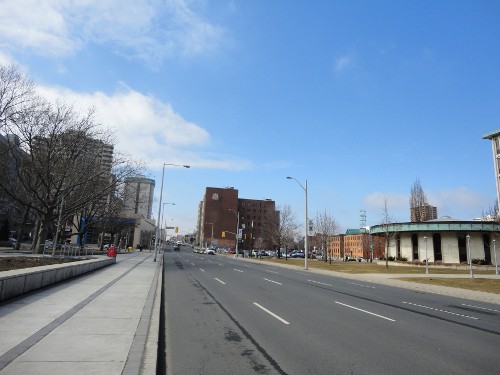
Main Street: five lanes of traffic, and none of them westbound (RTH file photo)
In design, usability refers to how easy it is for someone to learn and use an object - be it an appliance, a software application, a machine, a process or any other designed system.
A basic test of usability is how easily someone who is inexperienced with the system can figure out how to use it. A usable system will anticipate and leverage the user's own assumptions about how things work - for example, the assumption that a street goes both ways.
A usable system follows conventions that most users can recognize, and in which most users can successfully predict what a given action will do. At the same time, novel features are easily discoverable and the interface gives clear hints as to what they do and how to access them.
By such measures, Hamilton's one-way street system seems a failure. Anecdotally, an alarming proportion of people who drive into Hamilton from someplace else get lost and can't find their way out without help.
Certainly the first time I drove to Hamilton (as a teenager to see a concert at Copp's), I got hopelessly lost and ended up in the east end. I got lost again the first two times I drove to Hamilton as part of the process of moving here, and it was several months before I really got the hang of the place.
I'm sure someone will argue that our one-way streets ought to be easy to figure out and navigate. After all, the streets follow a grid and if there's an eastbound street, it stands to reason that there must also be an adjacent westbound street.
However, usability is based on what we actually observe in users. It's not based on a set of assumptions that sound reasonable but haven't been tested. Without applying evidence-based best practices to the design phase and employing user testing as early as possible to check assumptions against reality, any design is at best a crapshoot.
No matter how normatively sensible Hamilton's street network is, it is evidently not easy for people to figure out how to use it when they first encounter it.
Yet every attempt over the past decade to convert a one-way street to broader usability has been met with dire predictions of chaos and failure, based entirely on reasoning from a set of assumptions rather than observation and evidence. In the James/John South conversion, City staff tweaked the design over the next few months in response to some observed problems right after the cutover: that's classic iterative design for usability, and it flies in the face of the fearful letters to the editor that preceded it.
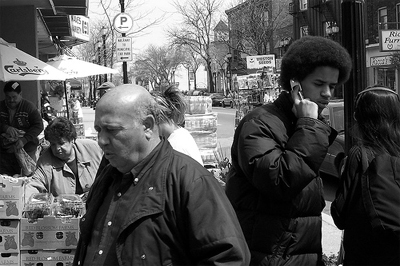
James Street North is a people-friendly place with streets that allow for diverse uses (RTH file photo)
Usability by itself isn't enough. To be successful, a street must also be useful to a variety of people.
When James Street was still one-way southbound, it was completely useless to anybody who wanted to drive northbound - including, crucially, anyone who wanted to drive northbound to a destination on James Street. (To do so, you needed to go north on a different street and then double back, which is a non-trivial aggravation given all the other destinations you could choose instead.)
By converting James Street from one-way southbound to two-way north- and southbound, the City immediately doubled the number of people for whom the street is useful.
Over time it's actually more than double. Because it's twice as easy to get to a destination on a two-way street as it is on a one-way street, destinations themselves tend to favour two-way streets over one-way streets.
As a result, converting a one-way street to two-way will tend to increase the number of destinations that choose to locate on it. Those destinations, in turn, will increase the street's overall usefulness by offering something to a broader sweep of people (who can approach a given destination from twice as many directions).
Now, an argument can be made that Hamilton's streets are optimized for expert users. After all, people who live here and drive across the city every day tend to appreciate them.
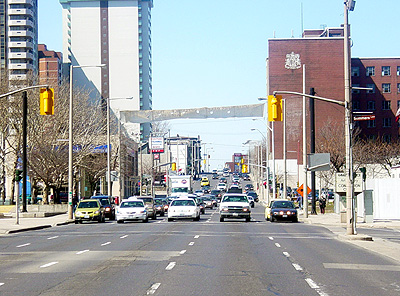
Main Street is an expressway in all but name (RTH file photo)
However, it seems to me that on a city street - the most fundamental piece of public infrastructure - it makes a lot more sense to target the broadest possible use: i.e. everyone.
A street designed for everyone will accommodate everyone: people who want to drive in either direction; people who want to drive to a local destination as well as a through destination; people who want (or need) to walk instead of driving; people who want (or need) to bicycle instead of driving; people who want (or need) to live and/or work on the street; people who don't want to travel at all but merely want to enjoy being in a public space; and so on.
Again, Hamilton's one-way thoroughfares fail this test, trading fast flow for through traffic against every other potential use.
Right now, Main Street is only useful to people who want to go quickly from the west end to the east end; whereas King and Cannon are only useful to people who want to go quickly from the east end to the west end.
So immediately, these streets are less appealing sites for driving destinations than they would be if they were two-way, since only half of the people who are driving to a destination can get to one on those streets.
But it's worse than that: because these streets feature multiple lanes of fast automobile traffic, they are also less appealing to pedestrians than streets with slower traffic would be. Most people who have a choice about where to walk will choose to walk on a different street.
So these streets suffer a double whammy, deterring almost half the drivers and most of the pedestrians who might otherwise choose destinations there.
King Street something of a special case in that it is restricted by design to just two westbound lanes between Wellington and Catharine, where it opens up again.
That relative bottleneck makes it less useful to westbound drivers, but more useful to people walking in the area because they're not walking next to multiple lanes of high speed traffic. It's no coincidence that this stretch is one of the few highlights of an otherwise dismal urban artery: the increase in usefulness to pedestrians more than offsets the decrease in usefulness to through drivers.
However, that is not an argument to maintain Main and King as one-way streets with slowed traffic. The only reason for these streets to be one-way is to increase their usefulness for fast through traffic, which is fundamentally incompatible with other uses.
If we're going to decide that broad usefulness is more important than the narrow goal of fast traffic flow, there's simply no other lingering benefit to keeping them one-way. It's not as if they're too narrow for two-way traffic: we're talking about four or five lanes of roadway on each street!
Also, as other commentators have pointed out, these streets have so much excess traffic capacity that we can cut the number of lanes down by half without impacting traffic speeds.
That means there's no reason we couldn't transform each of these streets to have one lane of traffic in each direction with left turn lanes and curbside parking on both sides. We would even have enough left over room for bike lanes.
Editor's note: This essay is part of a series on the future role and design of our downtown streets. We encourage Hamiltonians to submit well-written, thoughtful and evidence-based essays that move the discussion forward. Please send submissions to editor@raisethehammer.org.
By CouldaWouldaShoulda (anonymous) | Posted May 23, 2012 at 07:16:02
A perfectly salient article, Ryan. A good read.
"In the design of a city-changing endeavour - the most fundamental piece of public governance - it makes more sense to target the broadest possible element, i.e. everyone."
Well done. Glad to see we're on the same page. : )
By jason (registered) | Posted May 23, 2012 at 08:16:44
Good piece.... for the record, I'm an 'expert user' and hate them.
I feel for the residential homeowners on all the cross streets between King and Main who put up with me and hundreds of other people each day using their quiet side street as a shortcut back to the one-way pair.
Of course, one of the main reasons so many people, including residents of Hamilton, get confused and lost by this system is because it's so rare to find. Virtually everyone lives in a neighbourhood in our province with normal, easy to follow, two-way streets. It's already been pointed out on this site that the 403 ramps could easily be curved to encounter King/Main perpendicular, and allow for a regular stop light interchange.
I was reading through the Strathcona Transportation Master Plan documents this week for a large neighbourhood-wide planning process that is underway. Regarding King at the 403, the MTO responded to the group by saying "no stoplight would be allowed on King because it would be dangerous for drivers". This, despite the fact that the curve on King and the huge road width have been identified as massive safety hazards to pedestrians and cyclists. Heck, even as a driver I hate navigating those on/off ramps....only pro race car drivers should have to endure such craziness. Apparently the MTO finds it really dangerous for a driver to gently press their brake pedal at a red light....
By Grendel (anonymous) | Posted May 23, 2012 at 08:21:32
I often wonder if James and John North would be two-way today if the Papalia/Musitano feud hadn't boiled over in the late-90s. Considering the influence once wielded by those families, I suspect not.
By out of towner (anonymous) | Posted May 23, 2012 at 08:37:12
While we are at it what about signage? I find it nearly impossible, even after ten years of living in Flamborough to figure out which way is which on the major highways. For instance if one is in Ancaster does which direction on the highway does one take to go toward Toronto? Having signage that indicates Highway X West or Highway X East is next to useless. Many is the time I've found myself going the wrong direction on the Linc! Can we not get some extra signs with the additional direction (Toronto) or (Niagara)? This would be a big help. Part of the issue with King, Main etc is a similar lack of helpful (usable) signage that can help folk get where they need to be.
By arienc (registered) | Posted May 23, 2012 at 09:23:08
I have to relate this tale of driving in Hamilton just a few years back...shows just how inconvenient the one-way streets are for those who are looking to support downtown businesses.
By Pxtl (registered) - website | Posted May 23, 2012 at 09:41:14
To be fair, the green wave means they're effectively faster than a two-way street where traffic is moving with the same top-speed.
By jason (registered) | Posted May 23, 2012 at 09:54:48
some funny stories from the past hour downtown: I'm driving north on Dundurn and end up behind someone patiently waiting for pedestrians to cross so he can turn right onto King. At the last minute he realizes King is one-way and continues straight. I was sitting behind him thinking "bro, I feel your pain. If King was 2-way I'd be turning right too, instead of shortcutting through residential streets on Florence, Strathcona etc....
10 minutes later I'm headed east on York approaching Bay. I was in the left lane to head north on Bay when I encounter someone driving straight at me after having turned left onto York from Bay. Again, a logical scenario in any other city. It even looks two-way now with the nice big flower median. I thought they were going to turn that piece of York two-way to Queen when it was redone, but why do that when we can make the worlds largest and barely used left turn lane?
In my high-school days in Burlington, when my friends and I were first driving , getting totally turned around, lost and finally going the wrong way on a one-way side street in Hamilton was practically a rite of passage.
This does not give me feelings of rosy nostalgia.
By Gordie (anonymous) | Posted May 23, 2012 at 13:01:04
It's got to to be said, I HATE one way streets when driving. It's always a fight to get anywhere, especially anything on King St E. I always seem to either undershoot by a block (grr) or overshoot by 6 blocks (GRRRR!).
Another little brick of anecdotal evidence ...
... I used to sing the praises of the one-way main streets in this city. Back when I didn't like to admit that I lived here; back when I still sort of hated Hamilton.
The more I come to love this city and the more time I spend shopping, driving and walking in the heart of it, the more I hate the one-way expressways.
Comment edited by moylek on 2012-05-23 13:58:51
By Jimmy-James (anonymous) | Posted May 23, 2012 at 14:22:25
Interesting article. I don't agree with the premise at all. I always thought that safety trumps convenience and had assumed one way streets were safer for pedestrians.
I tried for 10-15 minutes to find evidence for or against one-way streets in a downtown core area, but found no scientific data that supported either argument. There is a lot of anecdotal evidence being passed along but I have yet to see a convincing literature review regarding the efficiency or safety of one way streets.
I have to wonder if convenience or safety can be used as arguments (for or against one-ways) if there is no evidence supporting either cause.
I did find a number of measures that Hamilton could easily implement to improve pedestrian safety, as it has been mentioned that walking next to busy city streets can leave a pedestrian feeling uneasy. I wonder if instead of one-ways we focus on pedestrian separation and visibility or vehicle speeds as measures to make the downtown core more pedestrian friendly and accessible.
By SpaceMonkey (registered) | Posted May 24, 2012 at 19:22:41 in reply to Comment 77218
Here is some information that I haven't seen mentioned.
The State of Oregon did a very objective and relevant study on how safety is effected by conversion from 2 way to 1 way.
The study is called "A study on One Way Street Routings in Urban Highways in Oregon"
The study looked at 12 different areas in Oregon (Portland I guess?) where streets were converted from 2 way streets into 1 way couplets. Data was collected for several years before and after the conversion.
All collisions before = 4755 All collisions after = 4295
pedestrian collisions before = 156 Pedestrian collisions after = 122
Someone questioned the rate of accidents. Although there is no data regarding accidents per number of pedestrians, there is data for accidents per million vehicle miles.
Accidents per MVM before = 41.27 Accidents per MVM after = 30.21
Accident rates decreased in 11 of the 12 areas studied.
The accident severity rate was shown to, on average, stay the same or reduce slightly after conversion to one way couplet.
Based on the above, I don't know how anyone can conclusively say that two way streets are, without question, safer than one way streets... even for pedestrians.
By BeulahAve (registered) | Posted May 24, 2012 at 07:11:06 in reply to Comment 77218
I spent about ten hours looking for evidence as well, not easy to find, even in the scholarly literature. But there is some. More has been written by municipal and planning people, but it is not always evidence-based. For a review of research evidence, please see Adrian Duyzer's May 23 post on pedestrian safety and Sarah Wayland's piece from today on the business case.
By mrgrande (registered) | Posted May 23, 2012 at 17:36:16
In the James/John South conversion, City staff tweaked the design over the next few months in response to some observed problems right after the cutover
Do you have any examples of what they changed? I'm curious.
By Brian C (anonymous) | Posted May 24, 2012 at 00:21:29
Re. Jimmy-James request to see a quality review of one way streets:
Jonathan, in response to another essay from today, provided an excellent study entitled "No Two Ways About It" http://www.i2i.org/articles/2-2005.pdf Lots of objective information, not just people's preferences. It is an American report but it does mention Hamilton on page 9.
By kevlahan (registered) | Posted May 24, 2012 at 03:51:08 in reply to Comment 77226
Randall O'Toole is a highly unreliable source if you're looking for objective evaluation of urban design issues, especially if you want a successful, pedestrian friendly downtown!
http://en.wikipedia.org/wiki/Randal_O'Toole
He actively promotes urban sprawl, is against public transit and receives much of his funding from the oil and gas industry. He is concerned not so much with the effectiveness of various urban planning decisions in creating healthy economically dynamic communities, but in opposing anything other than letting "market forces" operate freely. This neglects the fact that there are already all sorts of public subsidies at work promoting sprawl, notably public investment in roads and utilities.
His lack of objectivity and mis-representation of the facts is well-known:
"Many detractors have noted O'Toole's selective use of information, undocumented statistics, and unverifiable sources of information in order to support his claims against rail transit.[13][14] O'Toole has been criticized for declaring that roadways pay for themselves and are the best use of public funds, even though highways are some of the most expensive public works projects.[15]"
(from the wikipedia article)
For some real peer-reviewed analysis on one-way versus two-way and pedestrians see the references in Adrian Duyzer's article
http://raisethehammer.org/blog/2459/one-...
Comment edited by kevlahan on 2012-05-24 03:53:22
By kevlahan (registered) | Posted May 24, 2012 at 05:53:53 in reply to Comment 77229
And more on O'Toole's biased and flawed arguments:
http://www.streetsblog.org/2009/07/07/tr...
http://www.streetsblog.org/2009/06/02/ra...
Comment edited by kevlahan on 2012-05-24 05:55:38
By Mahesh_P_Butani (registered) - website | Posted May 24, 2012 at 10:43:26
Our city has suffered far too long at the hands of buzzwords and urban talking-heads expounding urban theories ad nauseam. When the science of 'Usability' is used to prop an ideology, it usually signifies an end of discovery, with predictable, almost comical outcomes.
"However, usability is based on what we actually observe in users. It's not based on a set of assumptions that sound reasonable but haven't been tested. Without applying evidence-based best practices to the design phase and employing user testing as early as possible to check assumptions against reality, any design is at best a crapshoot. ~ Ryan McGreal
So, let us apply evidence-based testing to check assumptions against reality:
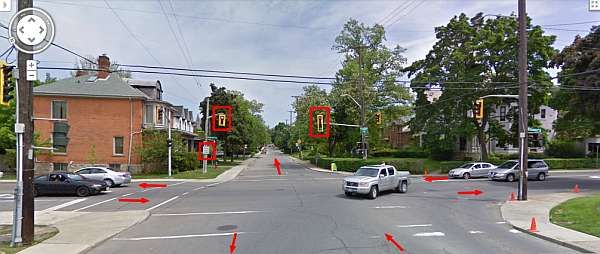
Aberdeen and Queen Street South Crossing - Facing East.
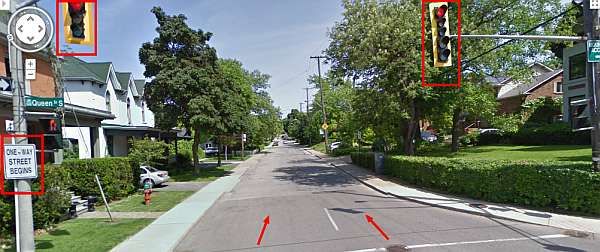
A Two-way street abruptly turns into a One-way street - leading into one of the most peaceful, safe, visually appealing, and most expensive neighbourhoods of Hamilton.
"...So immediately, these streets are less appealing sites for driving destinations than they would be if they were two-way,... ~ Ryan McGreal"
How does one explain this anomaly?
Or is good urban design nothing more than a series of well orchestrated anomalies which begs not to be codified by rules especially those driven by ideology?


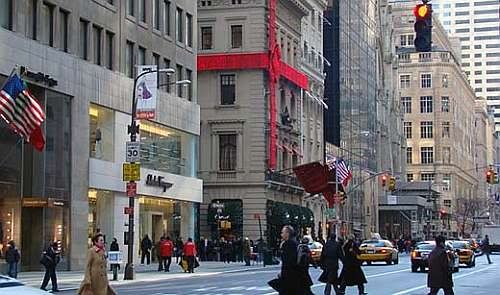
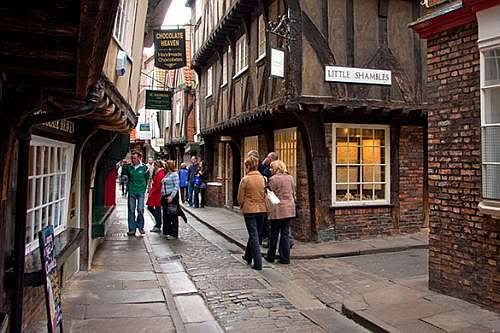
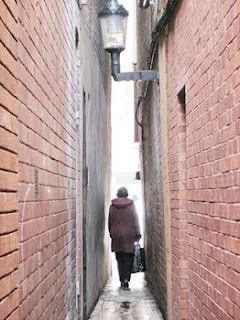
All streets are contextual. Main and King call to be addressed quite differently from each other, as well as from Cannon and Wilson. What is their context? is what we need to be discovering. The direction/s of their design will flow from this discovery.
"User experience (UX) is subjective, context-dependent and dynamic over time. Laboratory experiments [or ideologies] may work well for studying a specific aspect of user experience, but holistic user experience is optimally studied over a longer period of time with real users in a natural environment." ~ User experience evaluation
Mahesh P. Butani
By Help! (anonymous) | Posted May 24, 2012 at 11:27:53
Another great essay on street usability. Now how can we translate this into making our highways back into two way streets? How do we get the message to council and our transportation engineers?? In short what can I as a Hamiltonian do to help this along?
By 4phain (anonymous) | Posted May 24, 2012 at 13:45:54
Main Street: five lanes of traffic, and none of them westbound (RTH file photo)
My thought when I read this: five lanes of traffic, and none of them bike lanes.
By Skyrocket In Flight (anonymous) | Posted May 25, 2012 at 05:02:50
"A 44-year-old Ancaster man has lost his ride to an impound yard after Hamilton police clocked his pickup at more than twice the speed limit Wednesday.
Police clocked the truck doing 120 km/h in a 50 zone at 2 p.m. on Pritchard Road.
The truck was stopped, the driver handed a summons for stunt driving and the truck seized for seven days. The man’s licence was suspended for seven days too."
http://www.thespec.com/news/local/article/730275--speeder-clocked-at-more-than-double-the-limit
By Mahesh_P_Butani (registered) - website | Posted May 25, 2012 at 08:52:44
The current two-way street conversion clamour suffers from the same obtuseness that was present in the WH and LRT clamours. The end result was that valuable time and opportunities were wasted.
Once again, a great opportunity to debate and develop unique solutions to our downtown's short and long-term traffic patterns is being sandbagged by ideologues to force a point of view by any means necessary.
How this debate is going to end is very predictable and quite sad for a city of half a million with two centres of higher education.
Below is an example from a city where public discussions are not driven by ideology but by the spirit of discovery - the outcome is: contextual and grounded in evidence-based thinking. Can our local public discourse learn anything from this? I highly doubt it.
Changes to Traffic Patterns in Downtown Halifax
Some of the downtown Halifax streets have changed from one-way traffic, to two-way (and vice versa).
Initiated by a recommendation from HRMbyDesign and developed through public consultation, the changes in street directions have resulted in better organization of one-way street patterns. By converting two-way streets to one-way, the plan has allowed for new bike lanes and on-street parking spaces.
The first two phases of the changes occured during the fall 2011. The third phase will take place later this spring 2012. Phase 1: Sept. 19, 2011, Phase 2: Oct. 17, 2011.
To view a final street layout, once all of the changes are effective click here.
Over the past several years, HRM worked with downtown businesses on the development of a plan to modify traffic patterns on the downtown street network. The plan was first presented at an open house information session targeted at downtown businesses in April 2010. Since that time, modifications have been made based on feedback. A final proposal was presented at an open house session in November 2010."
"Phase II, Effective October 17, 2011. Traffic change: the two-way blocks on Lower Water Street will convert to one-way traffic flow in the North bound direction.

"Phase I Effective September 19, 2011. Streets affected by this change are: Converting to one-way: Blowers (between Grafton and Barrington), Market (between Prince and Carmichael), Sackville (between Brunswick and Barrington), George (between Barrington and Hollis) and Granville (between Salter and Sackville).
Converting to two-way: Grafton (between Prince and Sackville). Changing direction: Market Street (between Sackville and Prince).
View the Project Plan, Downtown Streets

Mahesh P. Butani
Comment edited by Mahesh_P_Butani on 2012-05-25 08:58:09
You must be logged in to comment.
There are no upcoming events right now.
Why not post one?